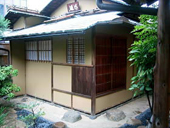 |
Tea Room with having main building
A hengaku* is hanged out on the top position of the wall.
It shows the heart of this founder.
*hengaku... framed picture or motto (usually horizontal, hung over gates or lintels) |
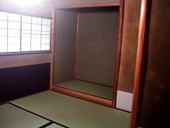 |
Tokonoma
This tokonoma has toko-bashira(an alcove post), tokokamachi*, otoshigake*. This is called 'Hondoko' style.
Kitayamasugi (Kitayama cedar trees) for a post, unpeeled cedar trees for a kamachi. Tatamibuchi* has a family crest design.
*Tokogamachi ...kamachi: an ornamental wooden bar in the front part of tokonoma)
*Otoshigake ...a bar placed across the upper part of the tokonoma
*Tatamibuchi...the edge border (overlapping) part of a tatami mat. It seems like a frame of tatami. |
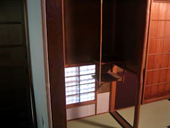 |
Katte-no-ma(one of Tokonoma)
There is a temporary placing rack for make a tea gathering smooth as possible. |
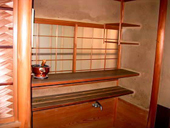 |
Shitsuke-mizuyadana(Cupboard shelf )
There are several shelves for organizing tea tools and a washstand for cleaning tea bowls. |
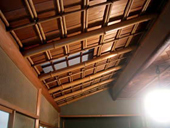 |
Kakekomi Tenjyo - ceiling consisting of different planes
Kaizurudake(reinforcement bamboo) is installed between bamboo balks, and 2 lined bamboo lathing are placed horizontally. Those decorative materials support sheathing roof boards. |
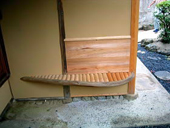 |
Koshikake( bench)
Making use of a curved crape myrtle, several short bamboos are embedded as a seating mat. The cedar tree boards are placed on only where the guest's back touches. |
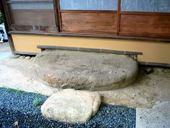 |
kutsunugi - ishi
A flat-topped stone is used for taking off one's shoes when entering inside. Especially this stone is installed when there is a big step between the inside floor and the outside ground. |
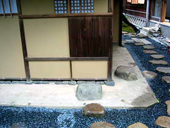 |
Nijiriguchi
It is a small door which leads guests into a tea ceremony hut(a brown sliding door in the middle of this photo). Guests have to bent over, or bow to get in a tea room physically. This motion is considered as a reverential attitude . |
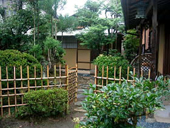 |
Nakamon(middle gate)
There are a lattice fence and a garden wicket of branches and twigs. The host welcomes guests at this gate. |
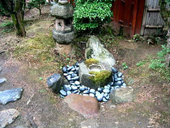 |
Chubachi-tsukubai(stone wash basin found in Japanese gardens)
A traditional tsukubai provided beside a teahouse including a "chozubachi (mizubachi) "at the center and three "yaku-ishi (a mae-ishi, a teshoku-ishi, and a yuoke-ishi)". When entering this garden, ladle out water from this wash basin. Purifying hands leads to a way of thinking to heal a heart. |
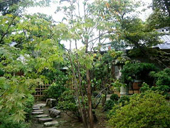 |
Roji (path through a garden next to teahouse)
Guests cross a stream in a garden by the stepping‐stones to a teahouse. Those stepping-stones are placed in a path to the teahouse. While guests walk on the regulated stones, they can be psyched up for a tea ceremony. |
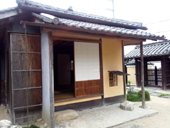 |
Renjimado( a lattice window)
Even if papered sliding doors are closed, it is possible to get the natural light from this small lattice window. |
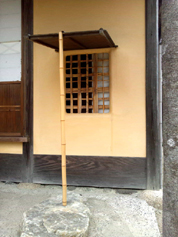 |
Tsukidasi-amado(sliding shutter)
To keep this sliding shutter open, pull up the wooden shutter and supports by a bamboo stick.
|
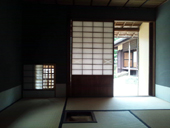 |
View from inside tea room
The inside of the room is not dark very much without any lighting equipment .
|
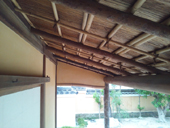 |
Komaikeraba
A cedar bark is covered on takekomai*, kakezurudake and rafters, and the long pole plate log supports the roof and other decorative materials.
*takekomai...the lath used on top of rafters beneath sheathing and roofing materials |

